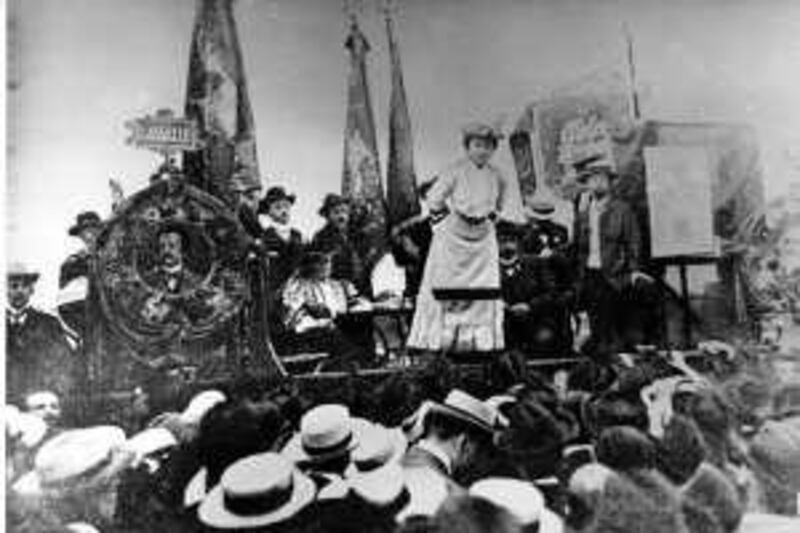BERLIN // For decades, students and doctors at Berlin's Charité Hospital paid little attention to the grey, headless corpse of an unidentified woman who had been dragged from a canal in 1919 and exhibited in a glass case in the hospital's Institute of Forensic Sciences. But the institute's director, Michael Tsokos, has now made the sensational claim that the corpse is that of Rosa Luxemburg, the firebrand communist revolutionary who was assassinated in January 1919 on the orders of the German government.
Luxemburg's grave in eastern Berlin's Friedrichsfelde cemetery, a pilgrimage site for leftists, contains the body of a different woman, said Prof Tsokos, who has found remarkable similarities between the hospital's corpse and the co-founder of Germany's Communist Party. They are of the same height and age at death - Luxemburg was 47 - and both had one leg slightly shorter than the other, the result of a dislocated hip Luxemburg had suffered from since birth.
Prof Tsokos, who was appointed head of the institute in 2007, decided to take a closer look at the mystery corpse because of decades-long rumours that Rosa Luxemburg had never been buried. He studied the original pathologists' report on the body buried in Friedrichsfelde and found that it had no dislocated hip and that its head injuries were not consistent with the rifle butt blows sustained by Luxemburg.
"You don't have to be an expert to conclude that this corpse wasn't Rosa Luxemburg," Prof Tsokos said. "The head injuries didn't result from rifle blows but from a fall." Historians agree that there was a lot of uncertainty at the time surrounding the identity of the woman buried as Rosa Luxemburg. The body in the official grave was found in May 1919 in the same canal where Luxemburg had been dumped four months earlier. Dr Tsokos believes the German authorities at the time forced pathologists to declare she was Rosa Luxemburg because they wanted to bury her as quickly as possible to help quell the bloody protests that followed her murder.
The Social Democrat government in 1919 was highly fragile as a result of political and social upheaval after Germany's defeat in the First World War. It wanted to remove Luxemburg, a Polish-born Marxist intellectual who was at the forefront of Germany's communist movement, because it feared she would incite a Soviet-style revolution in Germany. Luxemburg and a fellow revolutionary, Karl Liebknecht, were arrested in Berlin on January 15 1919 and taken to a hotel, where they were interrogated and beaten by troops under the command of Capt Waldemar Pabst, a far-right officer. The operation had the blessing of the defence minister, Gustav Noske.
Liebknecht was taken away and killed in the city's Tiergarten park. Soldiers shot him in the back so they could claim he was shot while trying to flee. Luxemburg was struck twice in the head with a rifle butt. Semi-conscious, she was bundled into a car and also driven to the Tiergarten. Her last words were reported to be: "Don't shoot." She was shot in the temple and dumped into a canal. It is a mystery why the body in the Charité has no head, lower arms or lower legs. Historians say the head may have been removed at the hospital and placed in formaldehyde where it may even now be stored amid the hundreds of unrecognisable heads kept for anatomical research purposes in the forensic institute's cellars.
Exhuming the body in Luxemburg's grave is unlikely to yield anything because it was probably removed when the Nazis destroyed the grave in 1935. Prof Tsokos is now trying to locate Rosa Luxemburg's original DNA to establish a match with the corpse and provide 100-per-cent proof of her identity. "He has gone public in the hope that someone can provide him with an item of clothing such as a hat that may contain a hair of Rosa Luxemburg for a DNA test. Hundreds of people have contacted him in recent days offering items that may contain her DNA, or information about possible descendants."
He tried and failed to retrieve traces of her saliva from the stamps of letters she had written. He is also trying to contact the last surviving relative of Rosa Luxemburg's, a 90-year-old niece who lives near Warsaw and is suffering from dementia, in a bid to find a DNA match. He also wants to trace a lock of Luxemburg's hair kept by her lover, a Frankfurt lawyer named Paul Levi, who emigrated to the United States.
Meanwhile, German left-wingers have called on the government to ensure that the mystery is solved. "We demand a full investigation under the auspices of the president and the government. The entire population has a right to this because Rosa Luxemburg was an outstanding figure in the German and international labour movement," the Left Party, successor to the Communist Party that ruled East Germany, said in a statement.
"Once the facts have been established, the issue of her dignified burial in her current tomb will have to be decided." dcrossland@thenational.ae






